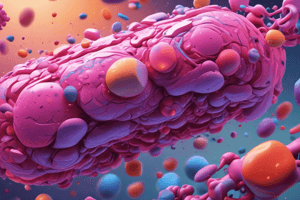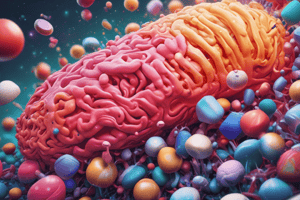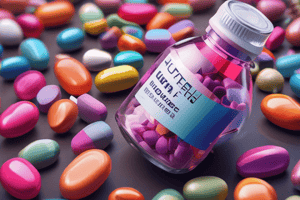Podcast
Questions and Answers
Aliskirin is a medication that belongs to a class known as:
Aliskirin is a medication that belongs to a class known as:
- Direct Renin Inhibitors (correct)
- Aldosterone Antagonists
- Angiotensin II Receptor Blockers
- ACE Inhibitors
What is the primary mechanism of action of calcium channel blockers (CCBs)?
What is the primary mechanism of action of calcium channel blockers (CCBs)?
- Prevents calcium from entering cells, especially in the heart and blood vessels (correct)
- Inhibits the renin-angiotensin-aldosterone system, leading to vasodilation
- Blocks sodium channels, reducing cardiac contractility
- Stimulates beta-adrenergic receptors, increasing heart rate and contractility
Which drug is specifically used for high blood pressure, heart failure, and nephropathy?
Which drug is specifically used for high blood pressure, heart failure, and nephropathy?
- Losartan
- Olmesartan
- Captopril (correct)
- Enalapril
Which of the following is a common therapeutic use of calcium channel blockers?
Which of the following is a common therapeutic use of calcium channel blockers?
Which category of medications inhibits the conversion of angiotensinogen into angiotensin I?
Which category of medications inhibits the conversion of angiotensinogen into angiotensin I?
Which adverse effect is associated with the use of calcium channel blockers?
Which adverse effect is associated with the use of calcium channel blockers?
Eplerenone is known for being a selective:
Eplerenone is known for being a selective:
Which specific calcium channel blocker is known to affect the heart more than others?
Which specific calcium channel blocker is known to affect the heart more than others?
Which drug category has the side effect of causing increased capillary permeability which can be fatal?
Which drug category has the side effect of causing increased capillary permeability which can be fatal?
Which class of drugs is considered a second-line option for the treatment of hypertension compared to calcium channel blockers?
Which class of drugs is considered a second-line option for the treatment of hypertension compared to calcium channel blockers?
"Category D" indicates that a medication:
"Category D" indicates that a medication:
Which of the following is a potential serious side effect associated with the use of the calcium channel blocker minoxidil?
Which of the following is a potential serious side effect associated with the use of the calcium channel blocker minoxidil?
"Category C in first trimester, and then Category D in second and third trimester" refers to the classification of drugs based on their:
"Category C in first trimester, and then Category D in second and third trimester" refers to the classification of drugs based on their:
How do calcium channel blockers differ in their mechanism of action compared to beta-blockers?
How do calcium channel blockers differ in their mechanism of action compared to beta-blockers?
What is the mechanism of action for organic nitrates?
What is the mechanism of action for organic nitrates?
Which condition is not listed as a therapeutic use for organic nitrates?
Which condition is not listed as a therapeutic use for organic nitrates?
What is a notable adverse effect of quinidine?
What is a notable adverse effect of quinidine?
Which drug class is specifically mentioned as having many drug interactions with quinidine?
Which drug class is specifically mentioned as having many drug interactions with quinidine?
Which food substance can increase the toxicity of quinidine by inhibiting its metabolism?
Which food substance can increase the toxicity of quinidine by inhibiting its metabolism?
What is an early sign of toxicity with quinidine that should be monitored?
What is an early sign of toxicity with quinidine that should be monitored?
Which drug class has a narrow therapeutic window with quinidine, where the effective dose is close to the toxic dose?
Which drug class has a narrow therapeutic window with quinidine, where the effective dose is close to the toxic dose?
Which of the following is NOT a mechanism of action for angiotensin-converting enzyme (ACE) inhibitors?
Which of the following is NOT a mechanism of action for angiotensin-converting enzyme (ACE) inhibitors?
What is the primary therapeutic use of angiotensin receptor blockers (ARBs) in patients with cardiovascular risk?
What is the primary therapeutic use of angiotensin receptor blockers (ARBs) in patients with cardiovascular risk?
Which of the following adverse effects is NOT commonly associated with ACE inhibitors?
Which of the following adverse effects is NOT commonly associated with ACE inhibitors?
Which syllable is commonly found in the names of angiotensin-converting enzyme (ACE) inhibitors?
Which syllable is commonly found in the names of angiotensin-converting enzyme (ACE) inhibitors?
Which of the following drug interactions is a concern with ACE inhibitors?
Which of the following drug interactions is a concern with ACE inhibitors?
Which of the following statements is TRUE regarding the administration of ACE inhibitors and ARBs?
Which of the following statements is TRUE regarding the administration of ACE inhibitors and ARBs?
Which of the following is a potential advantage of ARBs over ACE inhibitors?
Which of the following is a potential advantage of ARBs over ACE inhibitors?
Which of the following statements regarding the therapeutic uses of ACE inhibitors is INCORRECT?
Which of the following statements regarding the therapeutic uses of ACE inhibitors is INCORRECT?
Which of the following adverse effects is commonly associated with both ACE inhibitors and ARBs?
Which of the following adverse effects is commonly associated with both ACE inhibitors and ARBs?
What is the primary mechanism of action of Angiotensin Converting Enzyme Inhibitors (ACE Inhibitors)?
What is the primary mechanism of action of Angiotensin Converting Enzyme Inhibitors (ACE Inhibitors)?
Which of the following is a unique mechanism of action of Angiotensin Receptor Blockers (ARBs) compared to ACE Inhibitors?
Which of the following is a unique mechanism of action of Angiotensin Receptor Blockers (ARBs) compared to ACE Inhibitors?
What is a common side effect associated with both ACE Inhibitors and ARBs due to increased levels of bradykinins?
What is a common side effect associated with both ACE Inhibitors and ARBs due to increased levels of bradykinins?
Which of the following is a potential impact on tissues other than blood vessels due to the mechanism of action of ACE Inhibitors and ARBs?
Which of the following is a potential impact on tissues other than blood vessels due to the mechanism of action of ACE Inhibitors and ARBs?
How do ACE Inhibitors and ARBs primarily impact the Renin-Angiotensin-Aldosterone System?
How do ACE Inhibitors and ARBs primarily impact the Renin-Angiotensin-Aldosterone System?
What is a notable difference in the mechanism of action between ACE Inhibitors and ARBs regarding cough and angioedema?
What is a notable difference in the mechanism of action between ACE Inhibitors and ARBs regarding cough and angioedema?
What is a unique adverse effect associated with quinidine?
What is a unique adverse effect associated with quinidine?
Which medication works directly on smooth muscle to promote dilation of veins?
Which medication works directly on smooth muscle to promote dilation of veins?
Which adverse effect is an early sign of quinidine toxicity?
Which adverse effect is an early sign of quinidine toxicity?
What is the primary cause of angina pectoris?
What is the primary cause of angina pectoris?
Which drug category works on both tachy and brady mechanisms to treat dysrhythmias?
Which drug category works on both tachy and brady mechanisms to treat dysrhythmias?
What is the primary mechanism of action of grapefruit juice in relation to drug metabolism?
What is the primary mechanism of action of grapefruit juice in relation to drug metabolism?
Which drug has a chemical similarity to the nitro used in explosives?
Which drug has a chemical similarity to the nitro used in explosives?
What is the primary mechanism of action for aliskirin?
What is the primary mechanism of action for aliskirin?
Which drug class specifically inhibits the conversion of angiotensinogen into angiotensin I?
Which drug class specifically inhibits the conversion of angiotensinogen into angiotensin I?
What is the primary mechanism of action for eplerenone?
What is the primary mechanism of action for eplerenone?
Which drug mechanism involves the inhibition of the conversion of angiotensinogen into angiotensin I?
Which drug mechanism involves the inhibition of the conversion of angiotensinogen into angiotensin I?
What is the primary mechanism of action of calcium channel blockers (CCBs)?
What is the primary mechanism of action of calcium channel blockers (CCBs)?
Which of the following best describes the mechanism of action of organic nitrates?
Which of the following best describes the mechanism of action of organic nitrates?
How do calcium channel blockers differ in their mechanism of action compared to beta-blockers?
How do calcium channel blockers differ in their mechanism of action compared to beta-blockers?
Which of the following is the mechanism of action of cardiac glycosides, such as digoxin?
Which of the following is the mechanism of action of cardiac glycosides, such as digoxin?
What is the primary mechanism of action of angiotensin-converting enzyme (ACE) inhibitors?
What is the primary mechanism of action of angiotensin-converting enzyme (ACE) inhibitors?
Which of the following is the mechanism of action of angiotensin receptor blockers (ARBs)?
Which of the following is the mechanism of action of angiotensin receptor blockers (ARBs)?
Which of the following is the mechanism of action of potassium channel blockers in the treatment of dysrhythmias?
Which of the following is the mechanism of action of potassium channel blockers in the treatment of dysrhythmias?
Which of the following drugs is specifically used for high blood pressure, heart failure, and myocardial infarction?
Which of the following drugs is specifically used for high blood pressure, heart failure, and myocardial infarction?
Which of the following medications is a selective aldosterone receptor blocker used for hypertension and heart failure?
Which of the following medications is a selective aldosterone receptor blocker used for hypertension and heart failure?
Which drug class is particularly beneficial for patients with diabetes and is considered less of an issue in terms of adverse effects?
Which drug class is particularly beneficial for patients with diabetes and is considered less of an issue in terms of adverse effects?
What is the specific therapeutic use of aliskirin among the medications mentioned?
What is the specific therapeutic use of aliskirin among the medications mentioned?
Which one of these drugs is known for causing rebound hypertension if stopped abruptly?
Which one of these drugs is known for causing rebound hypertension if stopped abruptly?
Among the listed medications, which one is NOT primarily used for hypertension?
Among the listed medications, which one is NOT primarily used for hypertension?
Which drug is specifically indicated for hypertension, stroke prevention, and diabetic nephropathy?
Which drug is specifically indicated for hypertension, stroke prevention, and diabetic nephropathy?
What is the primary therapeutic use of organic nitrates?
What is the primary therapeutic use of organic nitrates?
Which drug category is specifically mentioned as having many drug interactions with quinidine?
Which drug category is specifically mentioned as having many drug interactions with quinidine?
What is a unique adverse effect associated with quinidine?
What is a unique adverse effect associated with quinidine?
What is an early sign of toxicity with quinidine that should be monitored?
What is an early sign of toxicity with quinidine that should be monitored?
Which drug category works on both tachy and brady mechanisms to treat dysrhythmias?
Which drug category works on both tachy and brady mechanisms to treat dysrhythmias?
Which drug has a chemical similarity to the nitro used in explosives?
Which drug has a chemical similarity to the nitro used in explosives?
What is the primary therapeutic use of calcium channel blockers (CCBs)?
What is the primary therapeutic use of calcium channel blockers (CCBs)?
Which of the following is NOT listed as a therapeutic use for organic nitrates?
Which of the following is NOT listed as a therapeutic use for organic nitrates?
What is the primary therapeutic use of cardiac glycosides, such as digoxin?
What is the primary therapeutic use of cardiac glycosides, such as digoxin?
Which medication class is specifically mentioned as being used for severe hypertension with potential serious side effects?
Which medication class is specifically mentioned as being used for severe hypertension with potential serious side effects?
Which medication class is considered a second-line option for the treatment of hypertension compared to calcium channel blockers?
Which medication class is considered a second-line option for the treatment of hypertension compared to calcium channel blockers?
Which medication class is specifically mentioned as being used in hypertensive emergencies due to its fast-acting nature?
Which medication class is specifically mentioned as being used in hypertensive emergencies due to its fast-acting nature?
Which of the following is NOT listed as a therapeutic use for calcium channel blockers (CCBs)?
Which of the following is NOT listed as a therapeutic use for calcium channel blockers (CCBs)?
Which of the following is a therapeutic use of angiotensin receptor blockers (ARBs) in patients with cardiovascular risk?
Which of the following is a therapeutic use of angiotensin receptor blockers (ARBs) in patients with cardiovascular risk?
Which specific therapeutic use of ACE inhibitors is not mentioned in the text?
Which specific therapeutic use of ACE inhibitors is not mentioned in the text?
What is a notable advantage of angiotensin receptor blockers (ARBs) compared to ACE inhibitors?
What is a notable advantage of angiotensin receptor blockers (ARBs) compared to ACE inhibitors?
Which of the following is a therapeutic use of ACE inhibitors that is not mentioned for angiotensin receptor blockers (ARBs) in the text?
Which of the following is a therapeutic use of ACE inhibitors that is not mentioned for angiotensin receptor blockers (ARBs) in the text?
Which of the following is a common therapeutic use of calcium channel blockers (CCBs) that is not mentioned for ACE inhibitors or ARBs in the text?
Which of the following is a common therapeutic use of calcium channel blockers (CCBs) that is not mentioned for ACE inhibitors or ARBs in the text?
Which of the following is a unique mechanism of action of angiotensin receptor blockers (ARBs) compared to ACE inhibitors?
Which of the following is a unique mechanism of action of angiotensin receptor blockers (ARBs) compared to ACE inhibitors?
Which of the following is a common adverse effect associated with both ACE inhibitors and angiotensin receptor blockers (ARBs)?
Which of the following is a common adverse effect associated with both ACE inhibitors and angiotensin receptor blockers (ARBs)?
Which of the following is a potential advantage of angiotensin receptor blockers (ARBs) over ACE inhibitors?
Which of the following is a potential advantage of angiotensin receptor blockers (ARBs) over ACE inhibitors?
Which of the following is a therapeutic use of ACE inhibitors that is not mentioned for angiotensin receptor blockers (ARBs) in the text?
Which of the following is a therapeutic use of ACE inhibitors that is not mentioned for angiotensin receptor blockers (ARBs) in the text?




